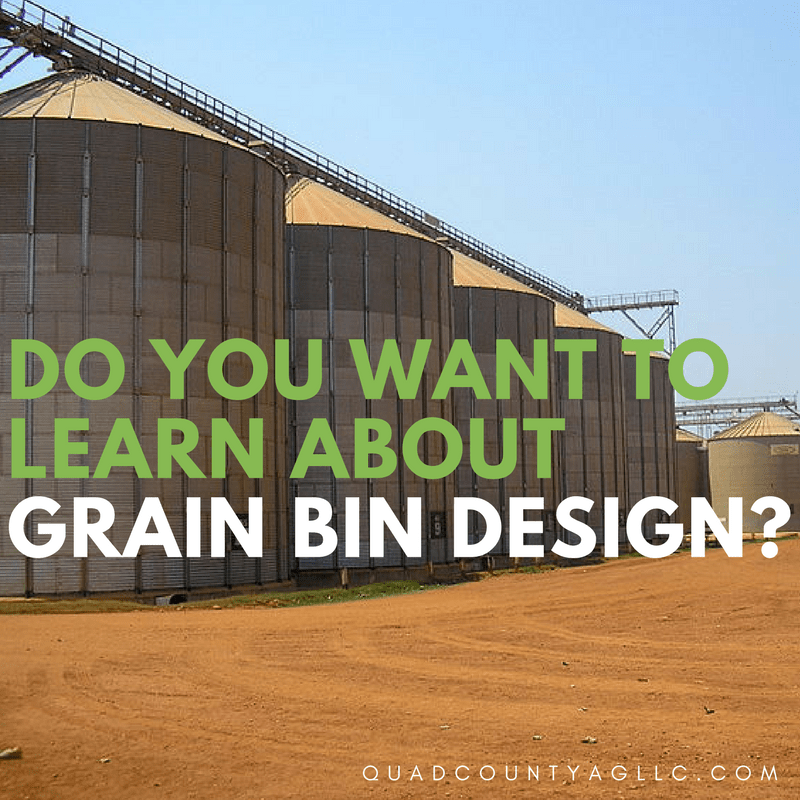
Home > Blog > Learn About The Grain Bin Design Process
Learn About The Grain Bin Design Process
Here at Quad County Ag, we handle all of the necessary steps to provide you with the highest quality grain bins for your farm. One of the most vital steps in this process is grain bin design. Every farm is different. Factors such as the type of grain that you grow, the weather that you experience in your area, and the space and budget that you have available will determine what kind of grain bin is best suited for your farm. That is why our expert team will work with you to first figure out your individual farm's needs and then come up with the perfect grain bin design for you.
We design grain bins for both smaller family farms and larger commercial farms. Whatever size or style of grain bin you need for your Midwest farm, contact the team at Quad County Ag right away.
Steps to Designing a Farm Grain Bin
There are a lot of different steps involved in designing and building grain bins for your farm. However, some of the key steps in the design process can be broken down as follows:
-
 Determine Storage Requirements: This step means answering questions such as how
much grain needs to be stored in the new bin?, how long will the
material remain inside the grain bin without movement?, will the grain
be at a higher or lower temperature than the outside environment?, is
the bulk material corrosive?, what are the main safety and environmental
considerations?, how likely is particle segregation/separation?, etc.
Determine Storage Requirements: This step means answering questions such as how
much grain needs to be stored in the new bin?, how long will the
material remain inside the grain bin without movement?, will the grain
be at a higher or lower temperature than the outside environment?, is
the bulk material corrosive?, what are the main safety and environmental
considerations?, how likely is particle segregation/separation?, etc. - Assess Bulk-Solids Flow Problems: the grain bin design must be ready to confront and control common problems with bulk material handling and flow, such as arching/bridging (material forms into a solid arch across bin outlet), flooding/flushing (the aerated bulk solid behaves like a fluid and flows through the outlet), or particle segregation (separation of particles by size, shape, density, etc.).
- Calculate the Bin Size: The bin must be larger enough to hold the desired amount of grain, but the height of the bin must also account for the volume lost at the top of the bulk due to the way the material heaps and should be between approximately one and four times the diameter or width of the cylinder.
- Determine the Flow Pattern: The way that the grain will flow through the storage bin will determine the overall design of the grain bin. After determining the predicted flow pattern of the bulk grain, the bin can be designed for mass flow or funnel-flow.
- Develop the Bin Geometry: Even though grain bins all appear to be very similar from the outside, there are a lot of different subtle difference between grain bin shapes. Some bins have square or rectangular straight-sided sections at the top, while some have circular sections, depending on the flow pattern and other details concerning the material.
- Select Functional Components: This includes deciding on the number of outlets, the outlet feeder, the bin vent or dust collector, the outlet gate or shut-off valve, the level detector, explosion protectors, access doors, ladders and railings, and other necessary components.
- Choose the Construction Materials: While there are a variety of materials that can be used to construct farm and commercial grain bins, we prefer to use high-quality steel materials that will withstand harsh weather conditions, constant stress, and the test of time.
Why Choose Quad County Ag for Grain Bin Design and Construction
Contact our team today to learn more about our grain bin design process and how we can get started designing a new grain bin for your farm. We will examine the area in which the grain bin is to be constructed and gather key information - whether it is a small area or a larger area, whether it is sheltered or exposed, etc. We will also consult with you to find out what your specific requirements are for the new grain bin.
Our team then handles the entire construction process as well as the design process. We pour the grain bin foundation and then work to build the entire thing. Your grain is the most important product that your farm produces. That is why our grain bins are securely built to protect your grain from the outside elements and to last for years to come. We also provide grain bin repair and millwright services if your grain bin should develop issues in the future or if you have an existing grain bin or a grain bin foundation that needs fixing. We even offer additional services such as a large product line for grain handling equipment and grain storage.
To learn more about any of our services, contact the team at Quad County Ag right away. We are proud to serve farms in all states in the Midwest and throughout the United States.
